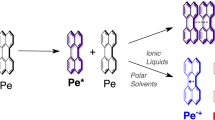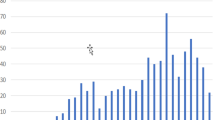Conclusions
-
1.
Hydrogen-atom transfer in quenching of triplet states of quinones by secondary aromatic amines takes place by establishment of prototropic equilibrium in the radical pair due to electron transfer. Electron transfer is the first event in quenching.
-
2.
The characteristics of the effect of the substituents and the medium on the position of prototropic equilibrium between radical pairs of neutral and charged radicals were established. A V-shaped dependence of the equilibrium constant on dielectric permeability in nonsolvating solvents was found. The specific solvation of hydroxyl-containing solvents results in a significant shift in the equilibrium toward formation of ion-radicals.
Similar content being viewed by others
Literature cited
D. Rehm and A. Weller, Isr. J. Chem.,8, 259 (1970).
V. A. Kuzmin, A. P. Darmanyan, and P. P. Levin, Chem. Phys. Lett.,63, 509 (1979).
P. P. Levin, A. P. Darmanyan, V. A. Kuz'min, A. Z. Yankelevich, and V. M. Kuznets, Izv. Akad. Nauk SSSR, Ser. Khim., 2744 (1980).
P. P. Levin and T. A. Kokrashvili, Izv. Akad. Nauk SSSR, Ser. Khim., 1234 (1981).
P. P. Levin, A. S. Tatikolov, and V. A. Kuz'min, Izv. Akad. Nauk SSSR, Ser. Khim., 1005 (1982).
R. Scheerer and M. Grätzel, J. Am. Chem. Soc.,99, 865 (1977).
C. Mann and K. Barnes, Electrochemical Reactions in Nonaqueous Systems, Dekker (1970).
K. S. Peters, S. C. Freilich, and C. G. Schaeffer, J. Am. Chem. Soc.,102, 5701 (1980).
C. G. Shaefer and K. S. Peters, J. Am. Chem. Soc., 102 (1980).
J. D. Simon and K. S. Peters, J. Am. Chem. Soc.,103, 6403 (1981).
R. A. Marcus, Ann. Rev. Phys. Chem.,15, 155 (1964).
V. Balzani, F. Bolletta, and F. Scandola, J. Am. Chem. Soc.,102 2152 (1980).
F. Wilkinson and J. Schroeder, J. Chem. Soc. Faraday Trans. 2,75, 441 (1979).
A. I. Kul'bida and V. M. Shraiber, Dokl. Akad. Nauk SSSR,250, 889 (1980).
Z. R. Grabowski and W. Rubazemska, J. Chem. Soc. Faraday Trans, 1,73, 11 (1977).
M. M. Davis, in: The Chemistry of Non-aqueous Solvents, J. J. Lagowski, ed., Wiley, New York (1970), p. 3.
N. D. Sokolov, The Hydrogen Bond [in Russian], Nauka, Moscow (1981).
A. B. Demyashkevich, N. K. Zaitsev, and M. G. Kuz'min, Khim. Vysok. Energii,16, 60 (1982).
Author information
Authors and Affiliations
Additional information
Translated from Izvestiya Akademii Nauk SSSR, Seriya Khimicheskaya, No. 2, pp. 284–290, February, 1983.
Rights and permissions
About this article
Cite this article
Levin, P.P., Kokrashvili, T.A. & Kuz'min, V.A. Effect of solvent and substituents on electron and hydrogen atom transfer in quenching of quinone triplets by secondary aromatic amines. Russ Chem Bull 32, 251–257 (1983). https://doi.org/10.1007/BF00957926
Received:
Issue Date:
DOI: https://doi.org/10.1007/BF00957926




